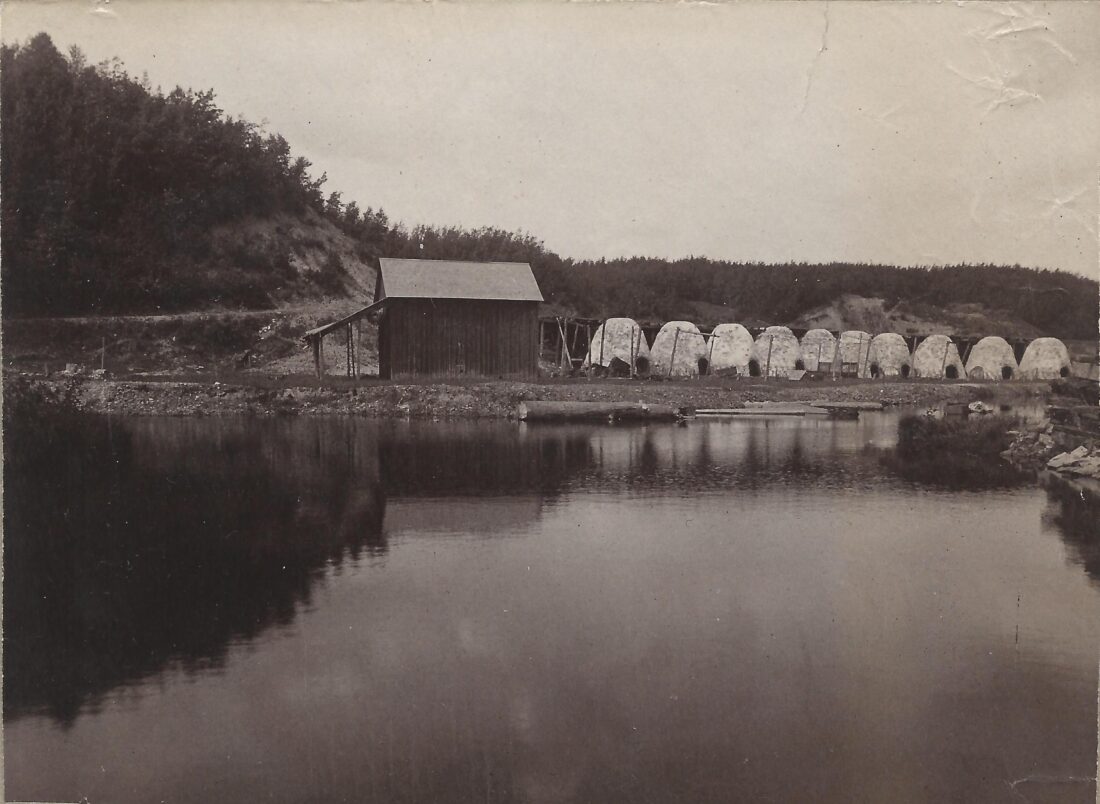Early iron making on the Marquette Iron Range (Part I)

A row of charcoal kilns at Forestville are pictured. (Photo courtesy of the Marquette Regional History Center)
By BETH GRUBER
Marquette Regional
History Center
Special to the Journal
MARQUETTE — The ores mined on the Marquette Iron Range are rocks and minerals from which metallic iron can be extracted. During the initial phases of mining, they focused on ores rich in iron oxides including magnetite (Fe3O4, 72.4% Fe) and hematite (Fe2O3, 69.9% Fe). After mining, the ore was smelted using heat and a chemical-reducing agent to decompose the ore, driving off other elements and leaving usable iron behind.
The reducing agent was typically carbon based. The Upper Peninsula provided an abundance of hardwoods to be converted into charcoal, so it became the primary fuel used by local iron makers. Charcoal is a lightweight black carbon residue produced by strongly heating wood in a minimal oxygen environment to remove all water and volatile constituents.
In the traditional version of this process, the wood was piled within a kiln and heat is supplied by burning part of the starting material itself, with a limited supply of oxygen. Charcoal burns at a higher temperature than wood, exceeding 2,010 degrees Fahrenheit (1,100 degrees Celsius) with hardly a visible flame, and releases almost nothing except heat and carbon dioxide.
There are ruins of kilns all over the area which are often more visible by satellite or air than from the ground. Perhaps the most noticeable beehive kiln was rebuilt by the Iron Ore Heritage Trail in 2019. It sits alongside US-41 just south of Marquette on the site of the Carp River Furnace complex which itself sat on the site of an earlier Native American village, Gichi-Naame-Ziibing.
The kilns were 25-35 feet high and held from 60-80 cords of wood. (A cord is 4 x 4 x 8 feet or 128 cubic feet.) Each acre of hardwood generally yielded 60 cords of wood which made 2,400 bushels of charcoal. When the kilns were loaded, they were sealed with sand at the top and lit through vent holes in the bottom which were sealed with rocks or sand as soon as the fires took hold.
The burning process took 10 to 12 days to complete, before the charcoal was allowed to cool for about a week. Great care had to be taken to have just the right amount of draft; if there was not enough draft, there might be an explosion and too much would lessen the amount of charcoal. Many kilns were painted with whitewash on the outside to make them more airtight.
Once the ore and charcoal had been acquired, they needed to be combined for smelting. In the late 1840s and early 1850s, the first ironworks built in Marquette County were four bloomery forges: the Carp River Forge (1847), at the site of the Michigan Iron Industry Museum near Negaunee; the Marquette Forge (1850), in south Marquette; the Buckeye/Forest Forge (1853), at Forestville; and the Collins Forge (1853), in Collinsville.
The bloomery was the earliest form of metallurgical furnace capable of smelting iron. A bloomery consists of a pit or chimney with heat-resistant walls made of earth, clay, or stone, usually between three and six feet in height. Near the bottom, one or more pipes (made of clay or metal) enter through the side walls. These pipes, called tuyeres, allow air to enter the furnace, either by natural draught or forced with hand bellows. An opening at the bottom of the bloomery may be used to remove the bloom, or the bloom removed from the top. Bloomery forges could either be cold- or hot-blast, depending on whether the incoming air was preheated.
The bloomery would be filled with a mixture of charcoal and crushed iron ore. As the charcoal burned, oxygen was chemically reduced from the ore, for example: Fe2O3 + 3C ? 2Fe + 3CO. Bloomeries could generally achieve temperatures up to a maximum of 1,800 degrees Fahrenheit/1,000 degrees Celsius, which did not reach the melting point of iron (2,800 degrees Fahrenheit/1,538 degrees Celsius), so the iron could not absorb carbon from the fuel.
The product, known as a bloom, was a spongy mass of pasty globules of metal, intermingled with a semiliquid waste material called slag. After removal from the forge, the bloom was repeatedly reheated and hot hammered to drive off the slag. The near-pure bloomery iron was malleable, allowing it to be hammered by blacksmiths into wrought iron products. The iron needed to be hardened by carburizing (adding carbon) to turn it into steel. Steel is an alloy of iron and carbon with improved strength and fracture resistance compared to other forms of iron.
Compared to Europe, the use of bloomery forge technology in this area was behind the times. Bloomery forges dated back to at least the 8th century and probably earlier. Blast furnaces developed in central Europe by the 13th and 14th centuries and were introduced into England around 1500. It is not clear why the early ironworks in Marquette chose bloomery technology although it is speculated that they required a smaller investment compared to the larger investment necessary for a blast furnace. Another possible explanation includes the difficulty of shipping the machinery needed for blast furnaces prior to the opening of the Soo Locks in 1855.
All four bloomery forges had short lives, going out of operation by the end of the 1850s with an estimated total output of less than 15,000 tons of iron. None of the forges ever returned a profit to investors. Next week’s article will discuss the area’s transition to using blast furnaces in iron making.




